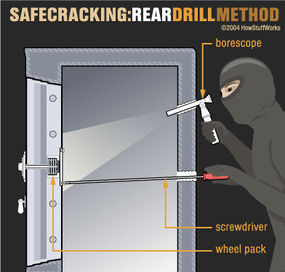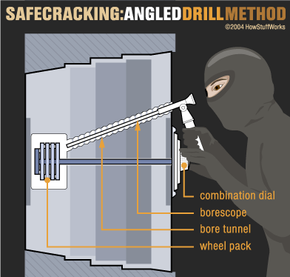Safe Manipulation
The most common method safecrackers use to manipulate the safe itself is drilling. There are several ways to use a drill to open a safe. The most direct method is to drill into the face of the lock in order to reach the lever or drive cam. After accessing the lever or cam, the safecracker can use a punch rod to push them out of the way or bend them until they are no longer obstructing the path of the bolt.
As a countermeasure to this, many safe manufactures have installed heavy cobalt plates to prevent or slow down drilling into the front of the lever and cam housing. Whether the cobalt actually prevents the drilling or simply slows it down depends on the type of drill bit the safecracker is using. Most any conventional drill bit will spin against the cobalt plate without ever penetrating it. However, if the safecracker is armed with say a titanium or diamond bit, it could eventually penetrate the cobalt. But, this would probably cost the cracker several drills (as the bits will outlast the motors) and, more importantly, too much time. As you know, time is enemy-number-one to a safecracker -- so, some other method would be employed.
Advertisement
Any skilled safecracker will, of course, know most everything about the safe he is drilling -- including any countermeasures put in place by the manufacturer. So, to counter this countermeasure, safecrackers can drill in at an angle above the cobalt plate and go straight for the wheel pack. The cracker's aim here is not to destroy the pack, but to see it. Using a small fiber-optic viewer called a borescope, the safecracker can watch the wheels spin as he turns the dial. Then it's just a matter of lining up the notches and watching the fence fall into place.
Now, you may be wondering, "If there are ways around the cobalt plate -- what's a safe maker to do?" Additional protection is provided by systems called relockers. Though the designs vary from manufacture to manufacture, the relocker is tripped when the safecracker's drill bit breaks a sheet of glass or plastic while drilling into the lock. Once this material is breached, it triggers a set of auxiliary locking devices which will lock out the safe completely. Even the proper combination will not open the safe once the relocker has been activated. The safe owner must call a safe technician or locksmith to retrieve the safes contents.
Side drilling is a method used to reach the bolt itself. The safecracker bores a hole into the side of the safe using a long nine- or ten-inch drill bit. A borescope is used to see the position of the bolt. Next, the safecracker takes a long punch rod and pushes the bolt out of the way.
Drilling holes in the rear of the safe is another method of attack. The safecracker drills two holes: one for the borescope and one for a special extra-long screwdriver. The safecracker uses the borescope to see the screws that attach the plate covering the wheel pack. Then he removes this plate and uses the screwdriver to move the wheels into position to allow the bolt to pass.
When drilling a safe, the thing safecrackers have to bear in mind is that even the smallest mistake could damage the safe beyond any hope of opening it at all.

These are just some of the more commonly used drilling methods. But, drilling is not the only way. Next, we'll look at some ways to open a safe that are even noisier than drilling.
